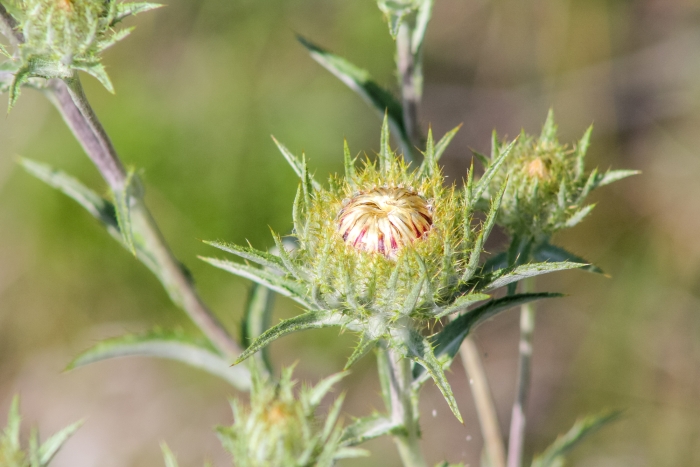Carline Thistle
(Carlina vulgaris)
Carline Thistle (Carlina vulgaris)
/
/

© Safina Rezeda
CC BY 4.0
Image By:
© Safina Rezeda
Recorded By:
Copyright:
CC BY 4.0
Copyright Notice:
Photo by: © Safina Rezeda | License Type: CC BY 4.0 | License URL: http://creativecommons.org/licenses/by/4.0/ | Uploader: safinarezeda | Publisher: iNaturalist |























Estimated Native Range
Summary
Carlina vulgaris, commonly known as Carline Thistle, is a biennial herb native to a variety of habitats including calcareous grasslands, chalk downlands, and coastal dunes across Europe, North Africa, and temperate regions of Asia. It is well-adapted to dry, sunny environments and thrives on well-drained, alkaline soils. Carline Thistle typically reaches up to 24 inches (60 cm) in height and features a distinctive flower head composed of small brown florets surrounded by stiff, brown-golden bracts that resemble a metallic sheen, blooming from July to September. The flower heads are remarkably drought-resistant and can appear almost metallic, making them quite showy despite their muted color palette.
Carline Thistle is valued for its unique appearance and is often used in xeriscaping and wildflower gardens due to its low water requirements and preference for poor soils. It is also appreciated for its long-lasting flower heads, which can be used in dried floral arrangements. In cultivation, it requires full sun exposure and thrives in well-drained, chalky or limestone soils. While it is not commonly afflicted by diseases, it can become invasive outside of its native range, particularly in North America, where it should be grown with caution to prevent unwanted spread.CC BY-SA 4.0
Carline Thistle is valued for its unique appearance and is often used in xeriscaping and wildflower gardens due to its low water requirements and preference for poor soils. It is also appreciated for its long-lasting flower heads, which can be used in dried floral arrangements. In cultivation, it requires full sun exposure and thrives in well-drained, chalky or limestone soils. While it is not commonly afflicted by diseases, it can become invasive outside of its native range, particularly in North America, where it should be grown with caution to prevent unwanted spread.CC BY-SA 4.0
Plant Description
- Plant Type: Herb
- Height: 0.5-2 feet
- Width: 0.5-1 feet
- Growth Rate: Moderate
- Flower Color: White, Brown
- Flowering Season: Summer, Fall
- Leaf Retention: Deciduous
Growth Requirements
- Sun: Full Sun
- Water: Low
- Drainage: Medium, Fast
Common Uses
Drought Tolerant, Low Maintenance
Natural Habitat
Calcareous grasslands, chalk downlands, and coastal dunes
Other Names
Common Names: Small Carline Thistle, Dwarf Carline Thistle
Scientific Names: , Carlina vulgaris, Carlina arophila, Carlina corymbosa, Carlina corymbosa, Carlina longifolia, Carlina racemosa, Carlina rhodopea var. plicata, Carlina rhodopea var. rhodopea, Carlina rigida var. sordida
GBIF Accepted Name: